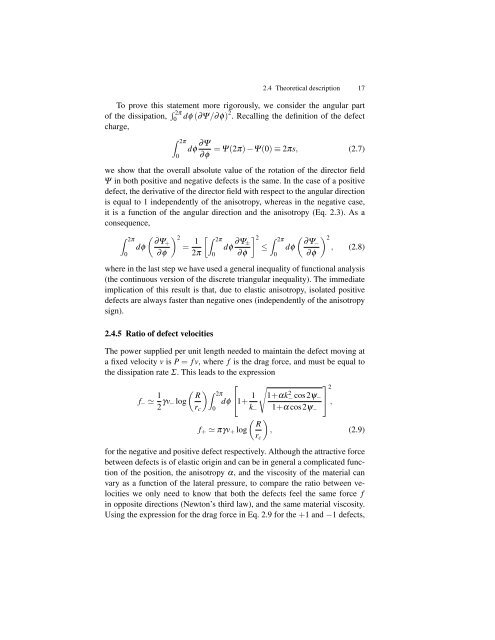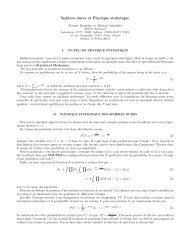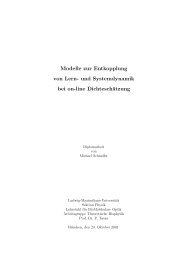Thesis (pdf) - Espci
Thesis (pdf) - Espci
Thesis (pdf) - Espci
Create successful ePaper yourself
Turn your PDF publications into a flip-book with our unique Google optimized e-Paper software.
2.4 Theoretical description 17<br />
To prove this statement more rigorously, we consider the angular part<br />
of the dissipation, 2π<br />
0 dφ (∂Ψ/∂φ)2 . Recalling the definition of the defect<br />
charge,<br />
2π<br />
0<br />
dφ ∂Ψ<br />
∂φ<br />
= Ψ(2π) −Ψ(0) ≡ 2πs, (2.7)<br />
we show that the overall absolute value of the rotation of the director field<br />
Ψ in both positive and negative defects is the same. In the case of a positive<br />
defect, the derivative of the director field with respect to the angular direction<br />
is equal to 1 independently of the anisotropy, whereas in the negative case,<br />
it is a function of the angular direction and the anisotropy (Eq. 2.3). As a<br />
consequence,<br />
2π<br />
0<br />
dφ<br />
2 ∂Ψ+<br />
=<br />
∂φ<br />
1<br />
2π<br />
dφ<br />
2π 0<br />
∂Ψ±<br />
2 2π<br />
≤ dφ<br />
∂φ 0<br />
2 ∂Ψ−<br />
, (2.8)<br />
∂φ<br />
where in the last step we have used a general inequality of functional analysis<br />
(the continuous version of the discrete triangular inequality). The immediate<br />
implication of this result is that, due to elastic anisotropy, isolated positive<br />
defects are always faster than negative ones (independently of the anisotropy<br />
sign).<br />
2.4.5 Ratio of defect velocities<br />
The power supplied per unit length needed to maintain the defect moving at<br />
a fixed velocity v is P = fv, where f is the drag force, and must be equal to<br />
the dissipation rate Σ. This leads to the expression<br />
f− 1<br />
2 γv−<br />
⎡<br />
<br />
R 2π<br />
log dφ ⎣1+ 1<br />
<br />
1+αk2 ⎤2<br />
− cos2ψ− ⎦ ,<br />
rc<br />
0<br />
k−<br />
rc<br />
1+α cos2ψ−<br />
<br />
R<br />
f+ πγv+ log , (2.9)<br />
for the negative and positive defect respectively. Although the attractive force<br />
between defects is of elastic origin and can be in general a complicated function<br />
of the position, the anisotropy α, and the viscosity of the material can<br />
vary as a function of the lateral pressure, to compare the ratio between velocities<br />
we only need to know that both the defects feel the same force f<br />
in opposite directions (Newton’s third law), and the same material viscosity.<br />
Using the expression for the drag force in Eq. 2.9 for the +1 and −1 defects,




